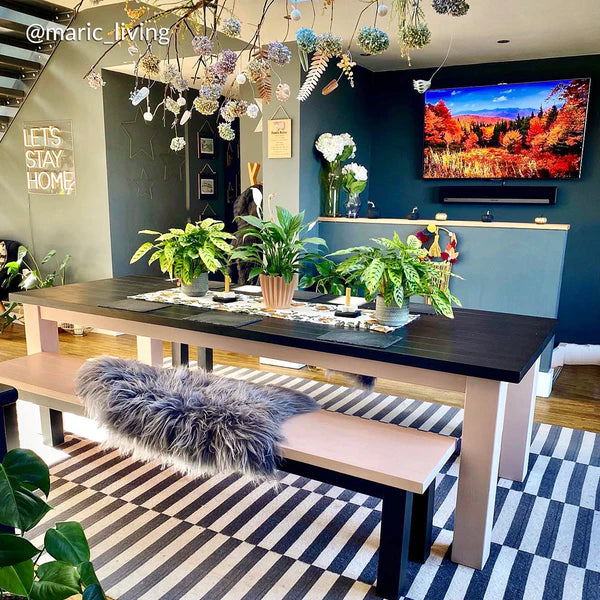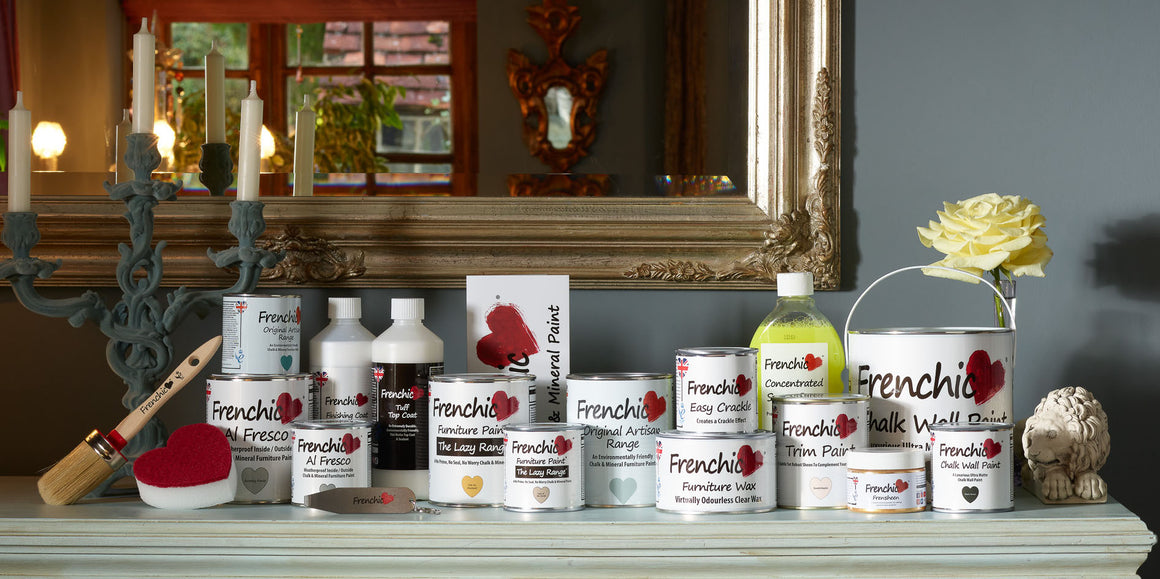
How to Paint Wooden Garage Doors
How to Paint Wooden Garage Doors
A lick of fresh paint is one of the best ways to breathe new life into a wooden garage door. Whether your garage door is street facing or backs onto an alleyway, a coat of high-quality Frenchic Al Fresco Paint will give it instant makeover.
Keep things classic with understated colours like Smudge and Cream Dream or make a statement with bold shades like Steel Teal.
In this guide, our brand ambassador Craig Phillips uses three different methods to paint wooden garage doors and frames:
- Classic paintbrush
- Small radiator roller
- Handheld paint sprayer
Whatever method you choose, Craig covers everything you need to know about how to prep and paint wooden garage doors and achieve a flawless finish – all outlined below…
What you’ll need
- Sugar Soap
- Cleaning products
- Flexible, paintable, exterior wood filler
- Sandpaper
- Dust mask
- Frenchic Finishing Coat
- Oval paintbrush, radiator roller or paint sprayer
- Suitable paint (Craig uses weatherproof Al Fresco paint in Blackjack and Smudge.
Preparing your wooden garage door
Start by cleaning all surfaces down with concentrated sugar soap. Dilute with warm water to create a cleaning solution. Aim for 1 part sugar soap, 10 parts water. Use a sponge to wash down your wooden garage door and frame. A small handheld scrubbing brush will help get into all the cracks and grooves. Rinse with clean water and a cloth. Then leave to fully dry before continuing with the prep work.
After the initial clean, use a cordless electric sander to smooth down the surface. If you don’t have a cordless sander, a block of sandpaper will do the trick. Always wear a dust mask when sanding!
Dust off debris and give your door a close inspection to check for cracks, gaps and holes. These can include large cracks in the timber itself, as well as cavities made by screws. Fill using flexible wood filler and a scraper. Leave to cure overnight, then sand down again so the surface is smooth and ready to paint.
As Craig says, it’s worth taking the time to do the prep work properly. This is the best way to achieve a robust finish that stands the test of time. It’s always best to give your garage door a good once over to catch any rough sections that need extra attention. Dust with an old paintbrush when you’re done, then wipe down with a damp cloth.
Sealing your wooden garage door
Once you’ve filled, sanded and cleaned your wooden garage door, it’s time to seal it. This prevents your paint from seeping into the porous filler and creating an uneven finish. Craig uses Frenchic Finishing Coat for best results. Rather than seal the entire door, simply feather the Finishing Coat over the filled sections using an old paintbrush or a small radiator roller. If your prep has meant a lot of sanding and large areas of bare wood are visible, it is a good idea to also apply Finishing Coat in these areas too.
Painting your wooden garage door
For any outdoor painting project, it is important to check the likely weather conditions for the day you are planning to paint and the following 48 hours.
Avoid painting if it’s likely to rain or if there is moisture in the air, and only paint when the temperature is between 10 and 32 degrees Celsius. Try to avoid painting in direct sunlight too, as this can make application trickier and sometimes impede the paint.
The rest depends on your choice of application method…
With a brush
Once your Finishing Coat is dry, use a high-quality round brush to apply your first coat of paint. Start with the top frame of the door. Apply paint in an up and down motion, following the natural grain of the wood. Make sure to push your bristles into the cracks and grooves for full coverage. Feather over the top of the crevices to create a smooth finish.
This is easy with Al Fresco paint, as it’s self-levelling to help you achieve a smooth finish. Goodbye streaks and brush marks! The Al Fresco range is also self-priming paint, meaning no additional primer or undercoat is necessary – not to mention self-sealing, meaning there’s need to worry about a topcoat.
With a roller
A small radiator roller is a good way to cover larger areas of your garage door. However, you may need to use a paintbrush to push paint into cracks and grooves, then go over with your roller. Alternatively, try tilting the edge of the roller to reach the crevices.
With a sprayer
If you are using a paint sprayer, you will need to thin the paint. Frenchic paint is lovely and thick, so you’ll need to dilute with around 10% tap water to run it through the sprayer. Stir well and start spraying! Hold the nozzle around four to six inches from the surface and spray in an up and down motion, from top to bottom. Turn down the paint and airflow settings if you’re new to sprayers. Don’t forget to mask up around the outside edges of the garage door to avoid overspray and extra clean-up work.
Applying the second coat
Once you have applied your first coat, wait a minimum of 2 hours before the second. You may need to give the first coat a quick sand. You don’t usually need to do this when using Al Fresco paint as the layers instantly bond and seal. However, when painting outdoors, paint can attract debris like dust and sand while drying. A quick once over with light sandpaper helps smooth out the surface and prepare it for the next coat.
If applying paint by hand using a brush or roller, two coats is usually enough. However, if you are using a sprayer, you will need to apply 3 or 4 coats because the paint is thinned – wait a minimum of 2 hours between coats.
Painting your wooden garage door frame
For the frame, it is usually best to use a brush. It’s a good idea to mask the brickwork before starting to simplify your clean-up. Don’t worry if your garage door frame has a plastic PVC trim. Al Fresco paint will glide over it with ease and dry perfectly. As always, leave to dry for a couple of hours before applying the second coat. If your garage door has locks or other metallic hardware, a coat of Frenshimmer will create a lustrous, high-end finish.
































